
95% of researchers rate our articles as excellent or good
Learn more about the work of our research integrity team to safeguard the quality of each article we publish.
Find out more
METHODS article
Front. Mar. Sci. , 19 June 2024
Sec. Ocean Observation
Volume 11 - 2024 | https://doi.org/10.3389/fmars.2024.1400397
Secchi-disk is an instrument that enables investigating water transparency, being reflective of sunlight to be used to measure the depth of light penetration in the water column. In biological marine research, the device is used to determine the intensity of primary production of planktonic algae. In the present study, we re-evaluated the practicality of Secchi’s method, developed some 160 years ago, for modern oceanography by using the same locations, methods, objectives, and comparable Secchi disk that were used in his survey in 1865. We show that the Secchi-disk is still a valid scientific method in environmental marine research and therefore defends its place reliably among modern electronical research infrastructure. Observer’s subjectivity didn’t have a significant effect on measuring but environmental conditions can influence ZSD determination in general. It is therefore justified to follow, for example, the general recommendations for the use of the Secchi net issued by HELCOM. Our results also revealed that ZSD was located about twofold deeper in 1865 than presently which cannot be explained only by annual variation. We show that green(ish) sea areas have today extended to larger sea areas than they were 160 years ago, due to an increase in the turbidity of the water resulting from, e.g., general eutrophication.
Padre Angelo Secchi (1818–1878) was an astronomer, astrophysicist, and a pioneer especially in the field of spectroscopy, He also was an Italian Jesuit, had an advisor post in the Vatican, and was a trusted friend of Pope Pius IV. In astronomy, he applied spectroscopy methods in the spectral classification of stars and made observations of star clusters, nebulae, the sun, planets, and comets (Secchi, 1863; Chinnici, 2019). In addition, he also influenced meteorology and was on the fringes of geodetic research (e.g., Secchi, 1860, 1870).
Although perhaps the least recognized of his inventions, his most significant contribution to oceanography was the development of the Secchi disk (Pitarch, 2020), a device that enables investigating the transparency of water. The Secchi disk is reflective of sunlight and is typically a white-painted metal plate that can be used to measure the depth of light penetration in the water column (Figure 1). The disk is attached to a measuring rope. In use, the plate is lowered down into the water column. The depth where the disk disappears, when observed from above the surface, is called the Secchi depth (ZSD). In biological marine research, the device is used, e.g., in pelagic and coastal sea areas, to determine the amount and intensity of the primary production of microscopic planktonic algae. By this method, one can get an estimate of the thickness of the so-called “productive layer,” i.e., the depth up to which the intensity of the sun’s light is still sufficient to stimulate the primary production of microalgae. The Secchi disk is the oldest method, which is in use, developed purely for marine research (Bowers et al., 2020).
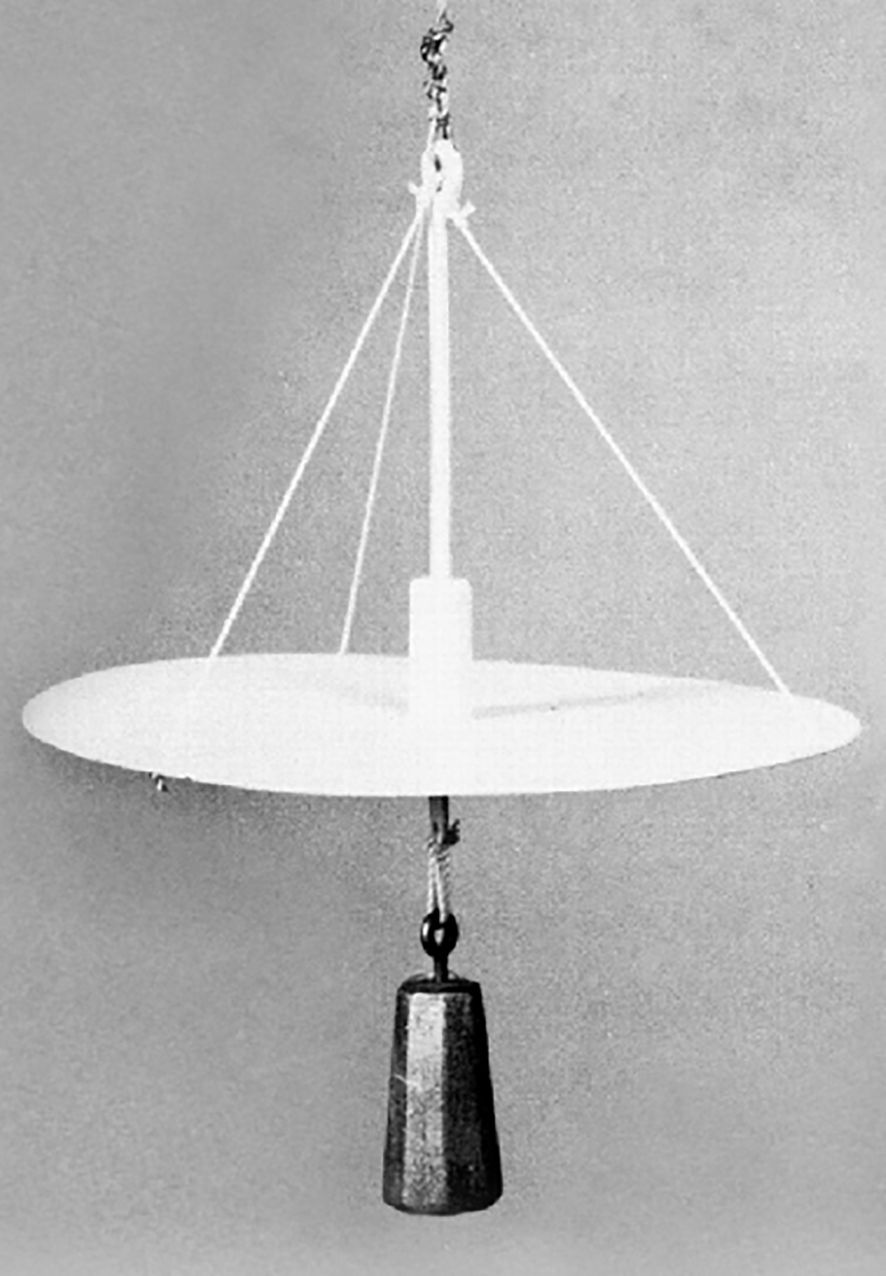
Figure 1 Illustrated example of a historical white-painted Secchi disk (Ø = 45 cm) used on board the streamer “Pola” during the Luksch’s survey already around 1890 in the Red Sea and Mediterranean Sea (derived from Wernand, 2010).
The original motivator behind the development of the Secchi disk was Alessandro Cialdi, Commander of the Papal Navy. Cialdi was interested in the possibility of identifying sea currents based on their transparency, i.e., clarity, turbidity, or the color of the seawater. Sea currents can significantly affect the passage of the ship on its route, thus their significance for navigation efficiency can be remarkable. For this purpose, Cialdi invited Secchi to join in his sea exploration survey in 1865 on the steam corvette “Immacolata Concezione” in the vicinity of Rome at the Tyrrhenian Sea. Cialdi had corresponded about his intentions with Secchi as early as 1859 when the pirocorvetta (steam corvette in Italian), the future pride of the Papal fleet, was being finalized at London’s Thames dockyard. The survey started on April 20 and lasted until the beginning of June. The trips were operated in the sea area near the town of Civitaveccia. In total, there were only nine measurement stations. During the same year, Secchi published a 35-page article about the trip results in the Il Nuovo Cimento publication series (Secchi, 1865).
In the present study, our aim was to repeat Secchi’s measurements by using the same season (early May), locations, methods, recommendations and protocols, objectives, and a comparable Secchi disk that were used during the Ciardi’s survey in 1865. With this, we aimed to evaluate whether this method, developed officially for marine science some 160 years ago, is still functional and practical in modern oceanography as well. As the Secchi disk is still widely used in everyday all over the world, we wanted to assess its methodological and scientific relevance in this way.
The study area is located in the northeastern Tyrrhenian Sea, which is a part of the Mediterranean Sea to the west of the mainland of Italy (Figure 2). The Tyrrhenian Sea is surrounded by the Apennine peninsula, Corsica, Sardinia, and Sicily. The deepest hollow of the sea reaches 3 785 meters (Millot, 1999). As the Tyrrhenian Sea is located on the confluence of the African and Eurasian continental plates, there are ridges and active volcanoes in the depths of it (Iacono et al., 2021). Convincingly, circulation in the Mediterranean Sea presents important seasonal variations that can be locally more intense than the annual mean (e.g., Pierini and Simioli, 1998, Millot, 1999). As many local winds interfere with the direction of the main winds, the ancient Greeks believed that the home of the winds was on the islets of the Tyrrhenian Sea. The Tyrrhenian Sea gets its name from the Etruscan (Barker and Rasmussen, 2000).
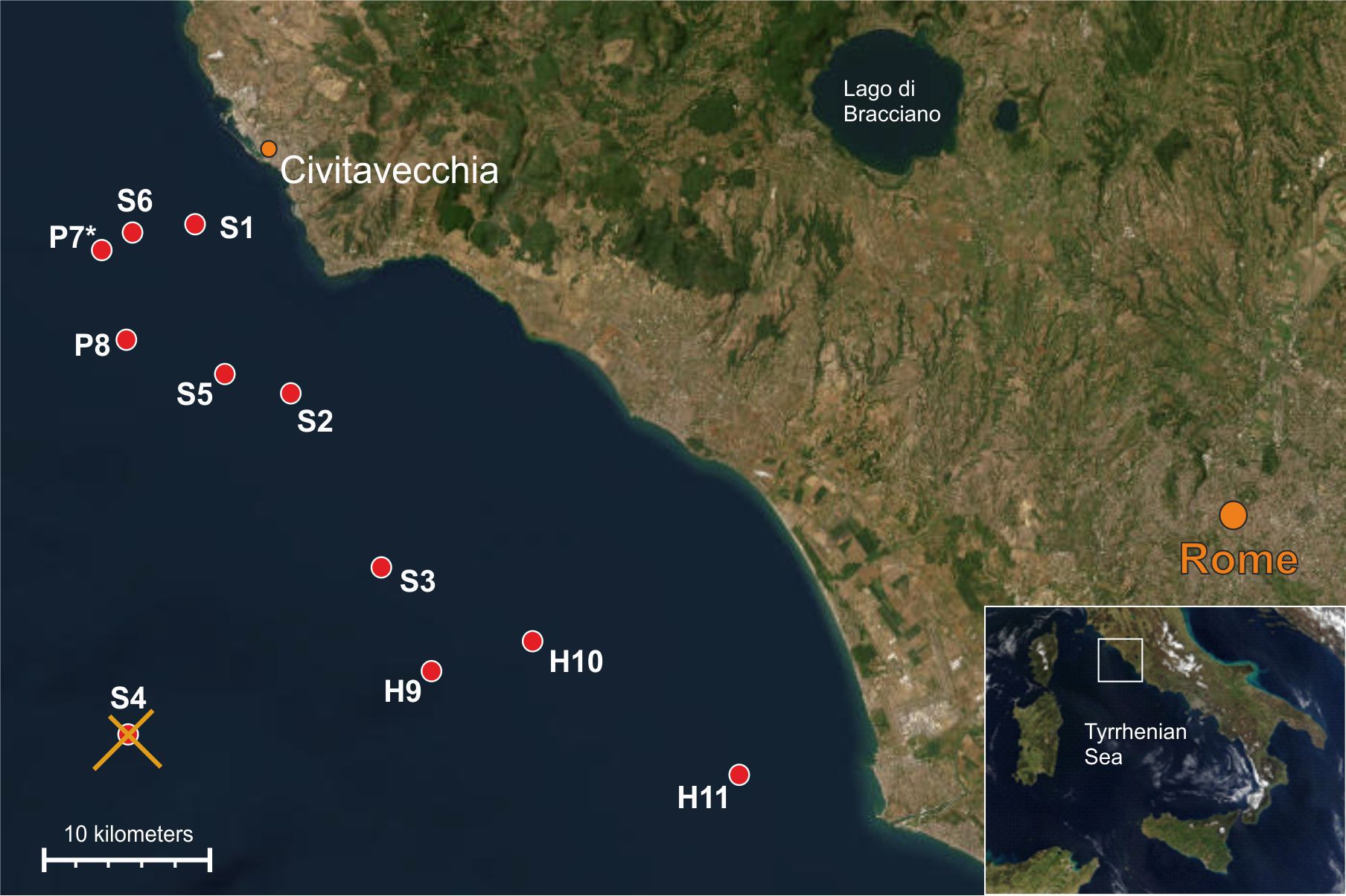
Figure 2 The northeastern Tyrrhenian Sea and measurement stations used in the present study selected according to Pitarch, 2020 and Secchi, 1865. S on the front of station number refers to original sites of Secchi’s cruise in 1865, P = station named by Pitarch, and H = station founded by Hänninen for this study. The asterisk at station P7 denotes that originally it was Secchi’s second measurement at the 6th experimental site. S4 was not included the analysis due to failed positioning by Pitarch (2020); See the text for more details. Image source: Landsat USGS.
The hydrology and the dynamics of the Tyrrhenian Sea are known, and the large-scale picture resulting from the experimental campaigns during the 20th century is summarized in several studies (e.g., Krivosheya, 1983; Millot, 1999; Millot & Taupier-Letage, 2005; Iacono et al., 2021). Among all the Mediterranean sub-basins, the Tyrrhenian Sea is well known for its complex current conditions and bathymetry, as its dynamics show a pronounced barotropic component. The barotropic component in the Tyrrhenian circulation suggests that the wind is likely to play a major role as a forcing agent supported by a purely wind-driven model of the Mediterranean (Pinardi and Navarra, 1993). There is the presence of a strong seasonality of the circulation in the surface layer. In winter, almost a basin-wide cyclonic circulation at all depths is present (Pierini and Simioli, 1998), and the area has a strong northwestward current of Atlantic waters, but in summer, a wide anticyclonic region is present off Campania, the Italian region including the Gulf of Naples (Iacono et al., 2021). In both cases, one could expect the presence of dynamical interactions with these isolated topographic features. Intermediate circulation obtained from observations and recent numerical studies agree and indicate the presence of a strong barotropic component in the dynamics of the basin. On the other hand, little is presently known about the structure of the deep circulation dynamics (Iacono et al., 2021). In any case, the southern Tyrrhenian Sea appears to be important in the mechanics of the whole Mediterranean Sea (Millot, 1999).
In general, the Mediterranean Sea is considered to be an oligotrophic basin with a few biological production hotspots, and some of these productive regions are influenced by large rivers’ discharges and suffer from eutrophication (e.g., Siokou-Frangou et al., 2010). Due to the strong barotropic component in the Tyrrhenian circulation (e.g., Sole et al., 2016), the tidal forcing (Sánchez-Garrido et al., 2015), and the meandering Atlantic Jet (Macias et al., 2006), the environmental state of the Tyrrhenian Sea follows main trends observed in the Mediterranean Sea. During the past decades, the Tyrrhenian coast has suffered from increasing amounts of human activities leading to environmental changes (Bosc et al., 2004).
Our aims in the present research are similar to Secchi’s original study, i.e., determining the transparency and color of seawater in relation to the sun position, weather, sea conditions, water depth, and the observer’s perception. The height above sea level was not applied, as the boat we were able to use in the cruise was smallish.
The present-day standard size of the Secchi disk is 20 cm (8 inches) in diameter (e.g., HElCOM 2017). However, for this research, we prepared a comparable replica of the device used by Secchi in his 1865 cruise (Figure 3). The rounded disk (Ø = 42 cm) was made of acid-proof steel (thickness = 5 mm, weight = 5.5 kg), which was painted as natural white resembling closely the majolica or sailcloth-white color used in Secchi’s devices. The disk was attached to the rope equipped with one-meter measuring marks, and it was operated from the passenger console of the Robalo type, outboard-powered boat Pequeño Nieto (length = 6.71 m, side height = 0.55 m) steered by the skipper Dario Rossi. Having a professional driver allowed us to concentrate properly on the research at sea. In use, except for the size of the disk, we followed protocols and guidelines of HELCOM (2017) for the monitoring of water transparency. Before the expedition, the replica was tested in the Baltic Sea to verify that the disk was heavy enough to descend quickly and was not affected by horizontal water movements, which, due to drifting, could bias measurements in varying weather conditions.
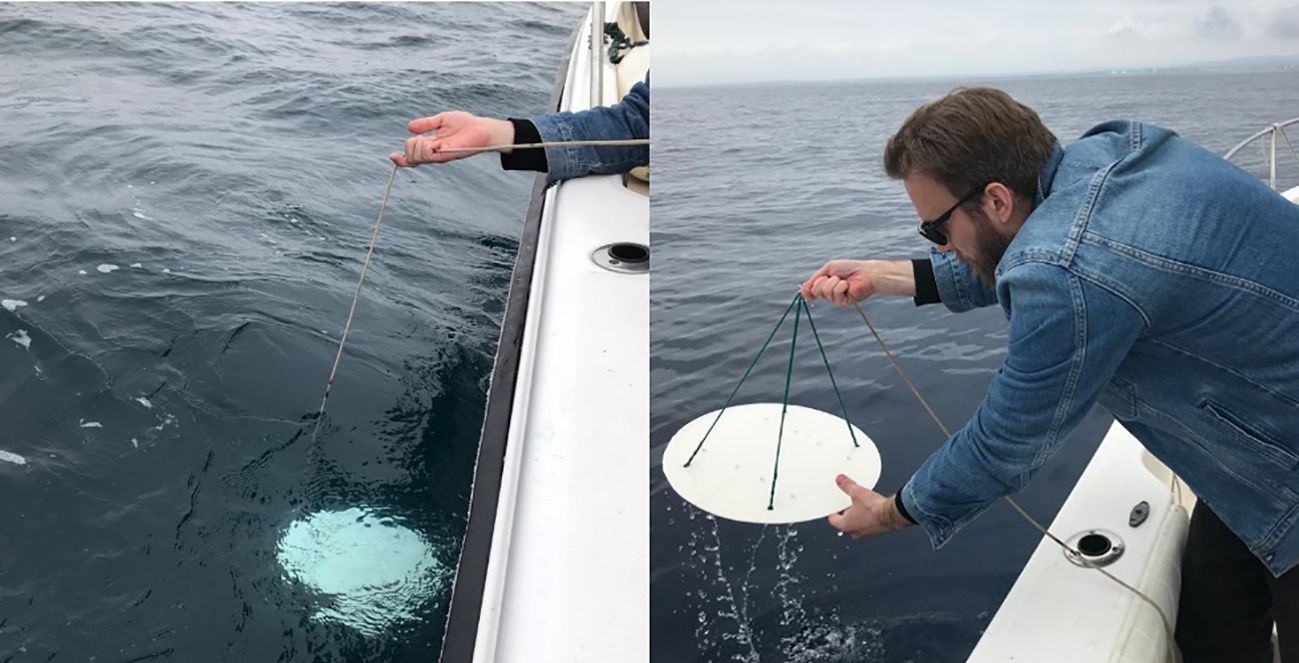
Figure 3 White painted Secchi disk replicate (Ø = 42 cm) in use on the board of “Pequeño Nieto” when testing the influence of polaroid sunglasses on the observer’s visual effects on observers’ perceptions to detect the disk. Photo: I. Vuorinen.
The measurement stations used in the present study were originally described by Secchi (1865) but was relocated by Pitarch (2020) (Figure 1). In his cruise, Secchi did not provide coordinates for the stations used, instead he verbally described locations of the sites based on compass directions and distance-visible landmarks and the depths of the sea. Also, he did not number or name the sites but instead called a single location as “esperimento”, i.e., experiment. One experiment could include two separate sites on two consecutive dates. That was the case with Secchi´s experiments 5 and 6. On that basis, Pitarch (2020) then positioned sites as the map locations and formulated coordinates for them (see Pitarch’s georeferenced materials at https://doi.org/10.5670/oceanog.2020.301). To be sure that these locations matched with Secchi’s experiments, we re-evaluated Pitarch’s positions by using Secchi’s original Italian descriptions. This showed that Pitarch was reasonably successful in positioning, and we agreed that stations 1–3 were in their correct places (Figure 2). However, he had evidently renamed originally two separate stations of experiment 6 to stations 6 and 7 and rejected another of originally two separate stations at experiment 5. Obviously, the reason for two separate locations at experimental sites 5 and 6 was that Secchi performed measurements on consecutive days. In our opinion, Pitarch also failed by positioning station 4 too far south and away from the coastline. Therefore, we completely rejected Pitarch’s station 4. Instead, he founded a new station 8 at the location where Secchi’s station 4 was originally situated. He also missed Secchi’s original station 7, which we, after repositioning, also omitted due to its distant location compared to the others and founded instead three new stations 9, 10, and 11 to increase the number of observations in the study (Figure 2).
The measurements at sea were performed by three methodologically experienced observers. The observers made their measurements independently as “blind”, i.e., they did not have the opportunity to receive information for each other’s measurement results before their own turn. None of the observers had significant corrections in their visual acuity for long-sightedness. The 4th team member acted as a registrar and wrote down the results given by the observers. Like Secchi, we made observations on both sides of the vessel, i.e., on the sunny and shady sides of the boat. The boat was positioned perpendicularly to the sun at each station.
At each station, we followed a fixed procedure in measurements, as Secchi did. When entering the station, we first checked the sea state that could have had a distorting effect on the observation if the weather was rough. Similarly, this could be also due to the sky brightness, cloudiness, and other possible noteworthy weather conditions, and these were observed at the same time. For environmental observations, we used here the same classification as Secchi (1865) and Pitarch (2020) used in their journeys (Table 1). Second, we wrote down the time of day that we later used for calculating the sun position (Azimuth) and elevation (° degrees above the horizon). This timing was repeated at the beginning of every later measurement by observers with the accuracy of five minutes.

Table 1 Scales of used environmental and weather conditions at study sites following the guiding classification of Secchi (1865) and Pitarch (2020) with corresponding Forel-Ule color* scale according to Burggraaff et al. (2021); See text for more details.
In actual measurements with the disk, the observer first assayed the color of the seawater. This was done twice by applying a disk sunken first to 1 meter below the sea surface following the instructions by Wernand and van der Woerd (2010), and then, to make sure, to the depth the disk hardly could be seen just before the actual Secchi depth. We followed the standardized color scale for visual seawater comparisons, i.e., the Forel-Ule scale (FU), but in classification, only concentrated on blue to green shades of color to avoid red-shifted color distortion presented by Wernand and van der Woerd (2010); Pitarch (2017, 2020) and Burggraaff et al. (2021) is presented in Table 1. After this, following the guidelines of HELCOM (2017), the actual measurements of the Secchi depth (ZSD) were conducted with a depth accuracy of 5 cm. The measurements were repeated altogether four times by each observer, i.e., on sunny and shady sides of the boat first without and then with polaroid sunglasses. By including polaroid sunglasses in the analysis, we wanted to test whether nowadays very commonly used anti-glare lenses in the observation of seawater transparency could influence on observer’s perceptual abilities. Each observer wore the same polaroid sunglasses (POLAROID 2133/S, Polaroid Eyewear™, density = 85%).
All statistical analyses were performed using the RStudio statistical software (Posit Team, 2023). To investigate the factors influencing water transparency, as measured by the Secchi depth (ZSD), a Linear mixed-effects model fit by REML (lmer) was used utilizing the “lmer” function from the lme4 package (Bates et al., 2015). Linear mixed models can contain one or more random terms if they follow a normal distribution. Moreover, these models are useful in situations where observations could be dependent on each other.
The numeric variable, the Secchi depth (ZSD), served as the dependent variable. The fixed effects considered in the analysis included Sun elevation, Polarized sunglasses (Plain/Polaroid), Sun position (Azimuth), Measuring side of the boat (Sunny/Shady), Sky state (cloudiness), Color of the sea, and Sea state. The random effects incorporated Observer and Station. We used Sattherthwaite’s approximation to define degrees of freedom for t-tests. The model’s fitting was estimated by using Restricted Maximum Likelihood (REML) estimation to reach the best parsimony of the model. The final formula for the linear mixed-effects model was specified as follows:
To assess differences in the mean Secchi depths (ZSD) across various factors, including Years (1865 and 2023), Use of sunglasses (Plain and Polaroid), Measuring side of the boat (Sunny and Shady), Color of the water (Green(ish) and Blue(ish) areas), Bottom depths (Shallow and Deep areas being < 50% or > 50% of median depths of the study area, respectively), Sun elevations (High and Low being > 50% or < 50% of horizon median, respectively), Sky cloudiness (Clear sky/Very slightly covered and Slightly covered/Moderate covered), and Sea state (Calm/Slightly moved and A bit rough/Moderate rough), the non-parametric Mann-Whitney test was applied. The choice of the Mann-Whitney test was justified by the small sample size. Additionally, a GLM (ANOVA) test was conducted to assess the differences in the Secchi depths attributed to each observer.
Focusing only on the white painted similar size of disk (material: majolica or cloth; Ø = 42 cm) in Secchi’s data, a total of 142 measurements were targeted for statistical analyses. Of these, 22 were gathered in an 1865 survey by Secchi and 120 in the present 2023 survey (Table 2). In 1865, half of the material was compiled from the shady side of the vessel. This was the case also with the 2023 data, but, half of the material were compiled wearing polaroid sunglasses as well. Depending on the observer, 20–24 of the measurements were located in the blue or blueish and 8–12 in green or greenish sea areas in the 2023 data. Similarly, an unclear situation, i.e., the blue/green color of seawater, was found in 8 to 12 measurements. Typically, a blue(ish) sea color was found in the outermost stations, whereas a green(ish) color was more common in the vicinity of the coastline. In 1865, Secchi did not assess sea color, thus we used only the 2023 data in the analysis.
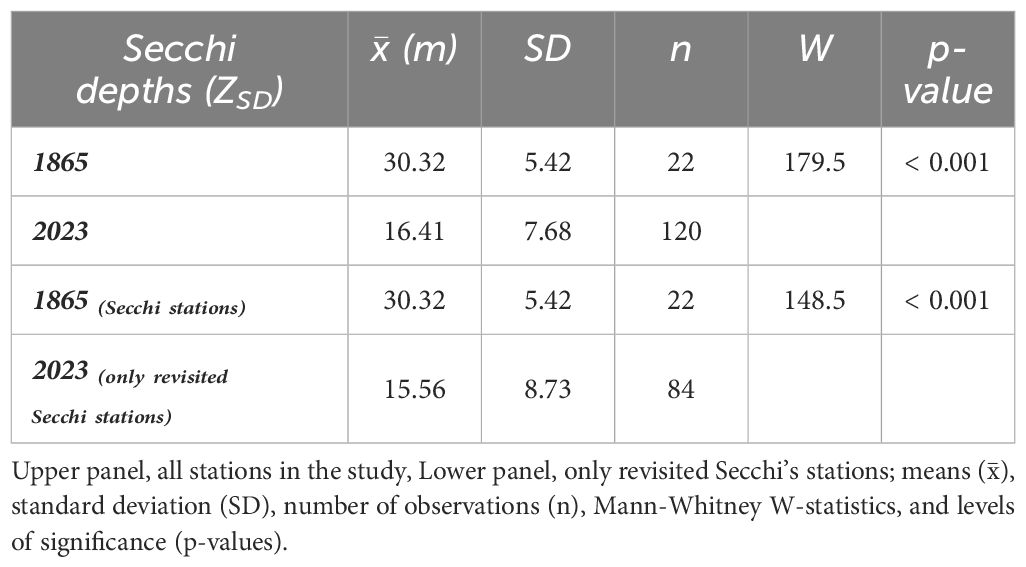
Table 2 Descriptive statistics and Mann-Whitney test results of locations of Secchi depths (ZSD) between 1865 and 2023.
As the Mann-Whitney test was used in combined data (Secchi stations + founded new ones) to compare the Secchi depth (ZSD) occurrence between the years 1865 and 2023, a significant statistical difference was obvious – at all, the ZSD was located about twofold deeper in 1865 than in 2023 (Table 2). The result remained the same, even though only the same stations used by Secchi were considered in the analysis.
The result was identical when the comparison was made pairwise station by station (Table 3; Figure 4). Most of the stations (57%) were at blue(ish) sea areas in 2023, and from these stations, the deepest Secchi depths were always measured. However, as the greatest changes in Secchi depths occurred in stations that presently are at green(ish) (S1, S2, S5) or blue(ish) (S6) sea areas (Figure 4), it gives an indication that, in 1865, the sea color situation in those stations was probably more tinged with blue. However, as Secchi did not conduct a seawater-color assessment, we are not able to verify this.
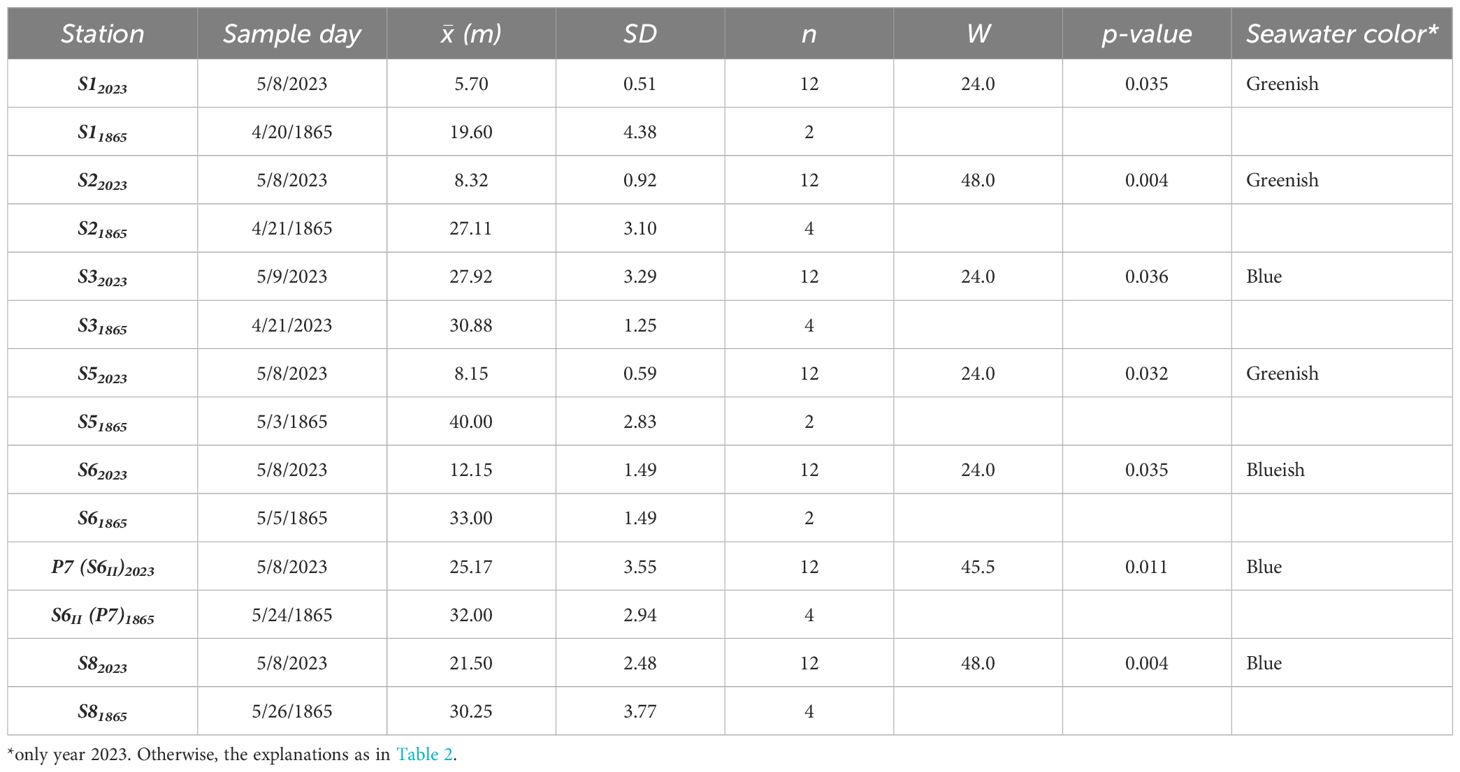
Table 3 Mann-Whitney test results of the Secchi depth (ZSD) values of Secchi stations between 1865 and 2023.
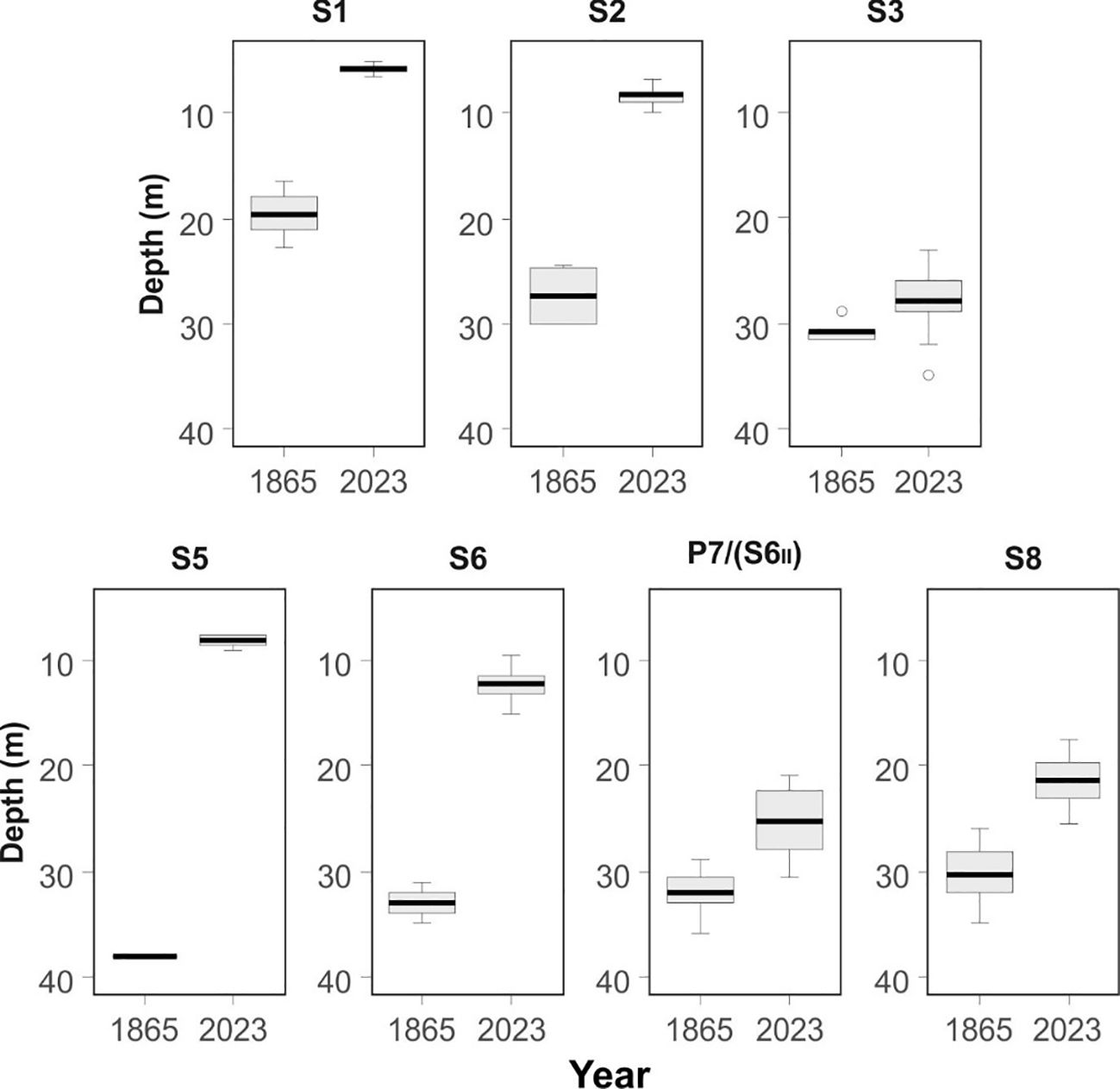
Figure 4 The Secchi depth (ZSD) scatter ranges at stations between 1865 and 2023. Thick black lines inside gray boxes show the mean of (ZSD) values, grey boxes indicate the middle 50% interquartile range (IQR) of observations, and line segments present 1.5 x IQR scattering (lower: Q1 – 1.5 x IQR, upper: Q3 + 1.5 x IQR). An observation is interpreted as an outlier when IQR > 1.5. Letter S on the front of station number refers to the original sites of Secchi’s cruise in 1865, P = station renamed by Pitarch (2020); see text for more details.
The perceptiveness of the observers and its possible qualitative effects on data were studied from several premises. The aim of this was to evaluate the effect of subjectivity or personal capacity in determining the Secchi depth (ZSD). For this, we used 2023 data, as we did not have reliable knowledge of the number of observers in 1865.
General variation or differences in an observer’s perceptual ability to determine the Secchi depth visually were tested by using General Linear Models (GLM). Based on the model Intercept, there exists a small-scale individual variation in an observer’s detection ability, i.e., JS likely had the best perception ability before IV and JV, respectively. However, no statistical difference was observed in the overall detection ability (Table 4).

Table 4 GLM test results of an observer’s differences to interpret the Secchi depth (ZSD) in 2023 in general, and Intercept estimates of perceptions among observers.
The result was aligned when the same comparison was made pairwise station by station. There was not irrefutable proof of a trend or pattern in variation among the observer’s perceptional abilities (Figure 5).
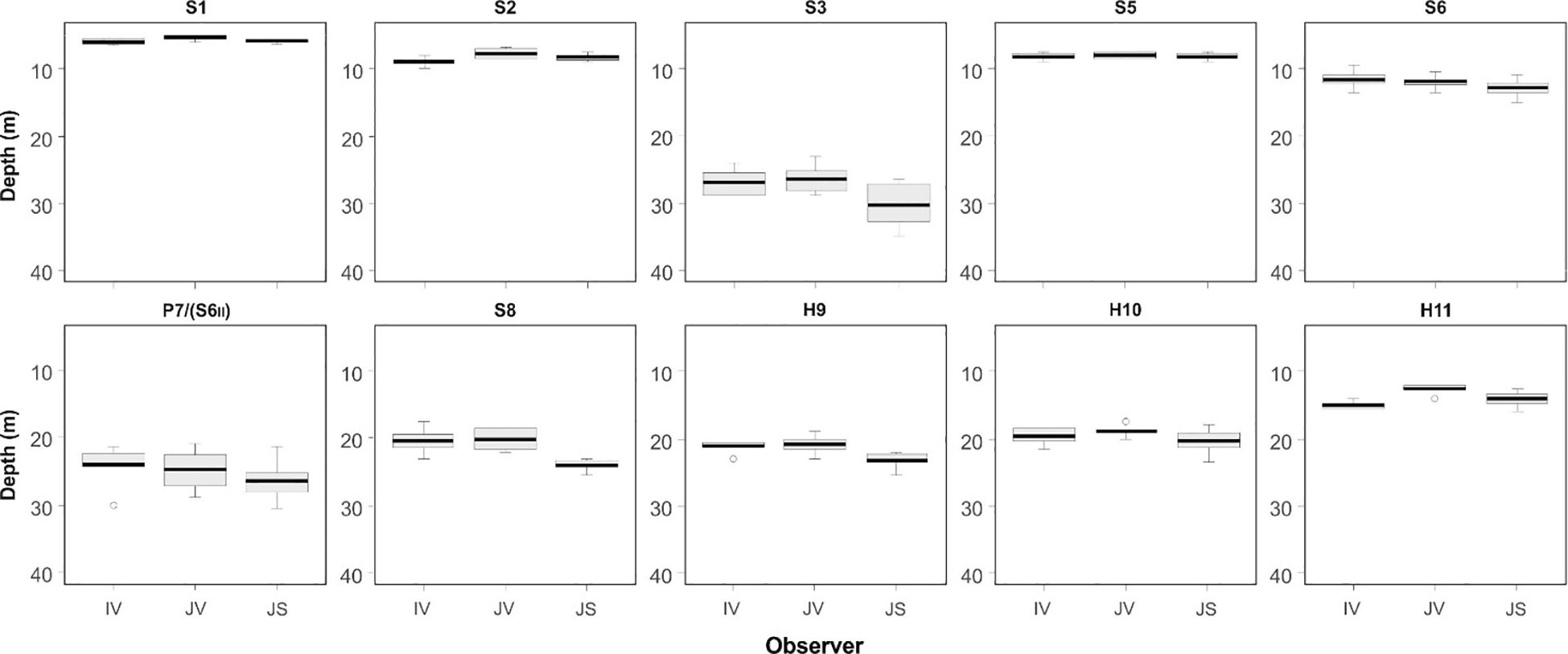
Figure 5 The Secchi depth (ZSD) scatter ranges at stations among observers. S on the front of station number refers to the original sites of Secchi’s cruise in 1865, P = station renamed by Pitarch (2020), and H = Hänninen stations measured in 2023; see text for more details. IV, JV, and JS refer to initials of observers. Otherwise, the explanations as in Figure 4.
Understandably, only 2023 data were used in comparison to the test to the effect of polarized sunglasses in detecting the Secchi depth by the observers. In general, the Mann-Whitney test did not show any statistically significant difference in the observations with plain-eyed or polarized vision (Table 5; two first rows).
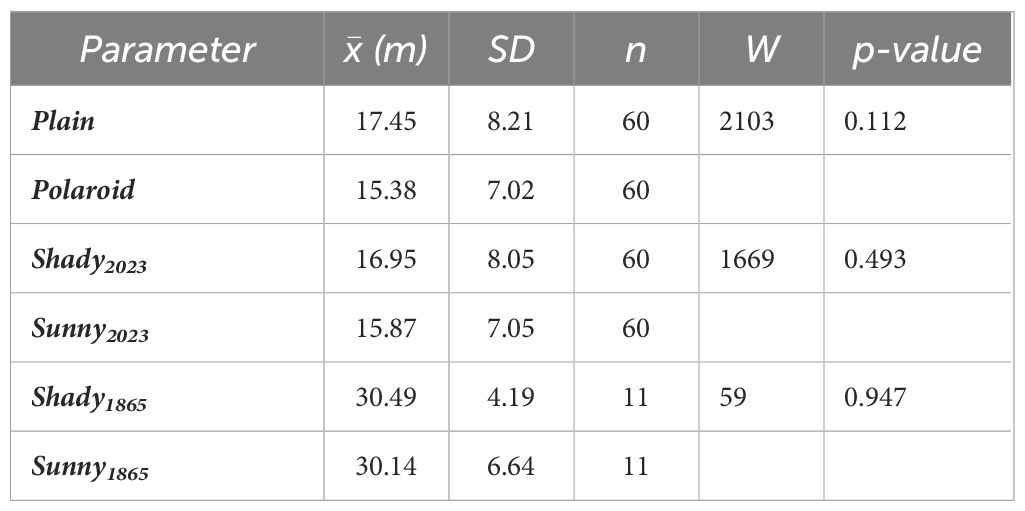
Table 5 Descriptive statistics and Mann-Whitney test results of the general effect of polaroid sunglasses and measurement site (sunny/shady side of the boat) in interpreting the Secchi depth (ZSD) in 1865 and/or 2023; means (), standard deviation (SD), number of observations (n), W-statistics, and p-values.
Exactly the same result was revealed when the observation abilities were examined individually (Table 6; upper panel).

Table 6 Descriptive statistics and Mann-Whitney test results of the effect of polaroid sunglasses (upper panel) and measurement site (sunny/shady side of the boat; lower panel) for personal faculties to interpret the Secchi depth (ZSD) in 2023.
However, as we applied Linear Mixed models to analyze whether polarized sunglasses have an influence on the outcome of the overall Secchi depth detection at stations and for observers, we found that, depending on the measurement position, the glasses had an effect that weakens an observer’s detection ability (negative t-value), i.e., with polarized glasses, an observer can suffer from impaired perception (Table 7). When we were at the sea conducting measurements, we noticed this to be case especially at the blue(ish) water stations (S3, P7(S6II), S8, H9), where the ZSD were positioned in notably deeper water (Figure 5).
As there has been presented a recommendation that, “Secchi disk measurements should always be taken off the shady size of the boat or dock between 10.00 and 14.00” (e.g., Lind, 1985; HELCOM, 2017), we wanted to test how much it could create bias between shady and sunny boat side measurements. We did this with three separate tests.
When the 2023 data were analyzed with the Mann-Whitney test to compare the effect of the shady and sunny side of the boat on measurements results in observing the ZSD, no statistically significant difference was found (Table 5; lower panel). The result was the same when the comparison was made pairwise station by station (Figure 6). Correspondingly, no significant differences between stations or among observers were found in the Linear mixed model results, regardless of the shady or sunny side of boat (Table 7).
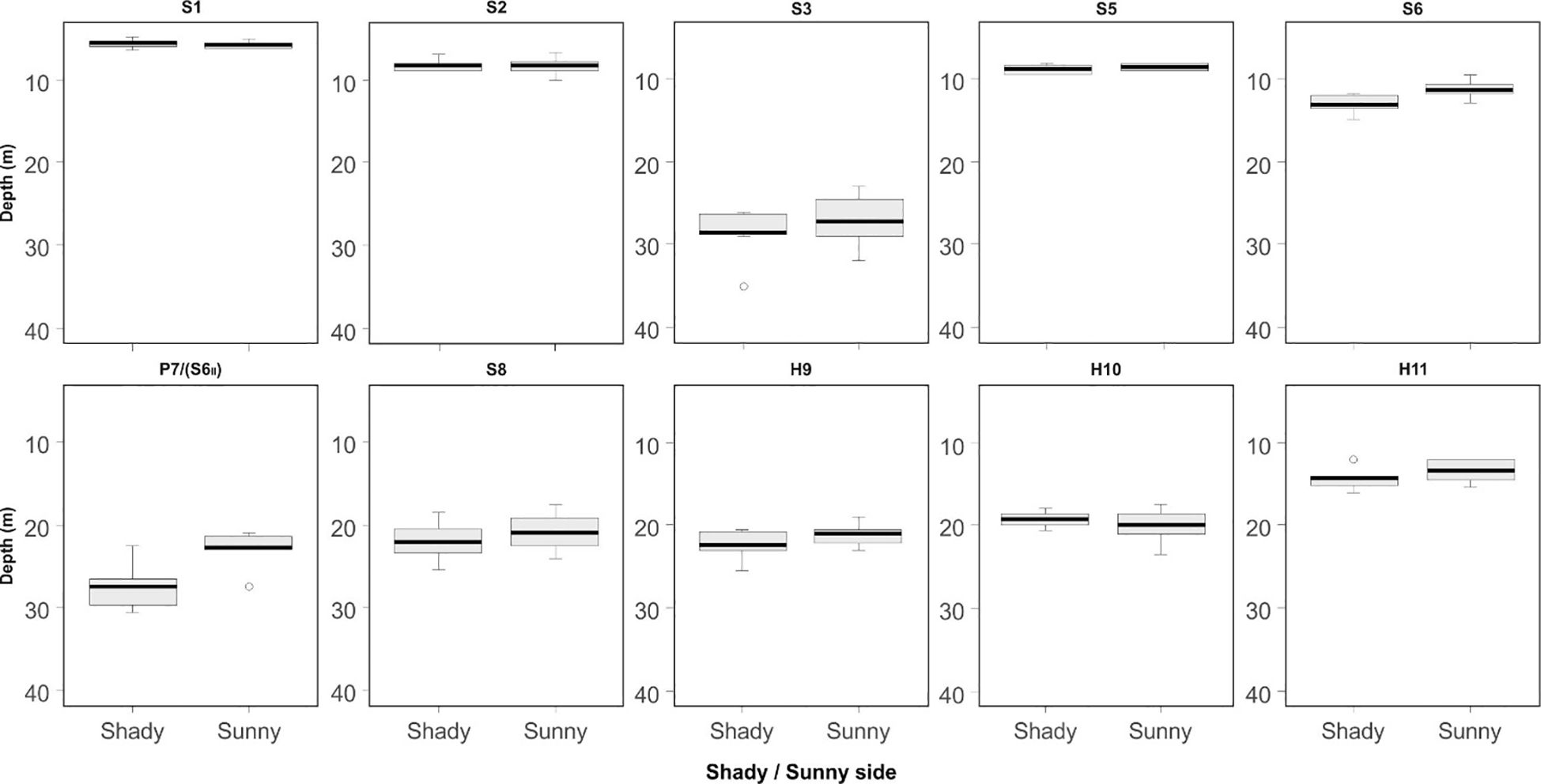
Figure 6 The Secchi depth (ZSD) scatter ranges at the stations when measuring the shady and sunny sides of the boat. Otherwise, similar explanations as in Figures 4, 5. See text for more details.
Another recommendation for the use of Secchi disk has been that, “measurements should take only bright and calm weather conditions since the angle of the sun and waves can affect readings” (e.g., Lind, 1985; HELCOM, 2017). Therefore, in the present study, we wanted to test whether the effect of cloudiness and the state of the sea had a distorting effect on an observer’s perceptions.
During the field work week, we did not have all the possible scales of cloudiness or sea conditions. Values 1, 2, 3, and 4 occurred in cloudiness, and in the state of the sea, the scale also was 1, 2, 3, and 4, respectively (Table 1). With the data used, a clear statistical difference was noticed in the Mann-Whitney test for the effect of cloudiness on an observer’s perceptions of Secchi depth, but the result for the state of the sea indicated only a marginally significant effect on perceptiveness (Table 8; Figure 7). However, the Linear mixed model revealed no significant effect between stations or among observers for either of the weather parameters in the data used (Table 7).
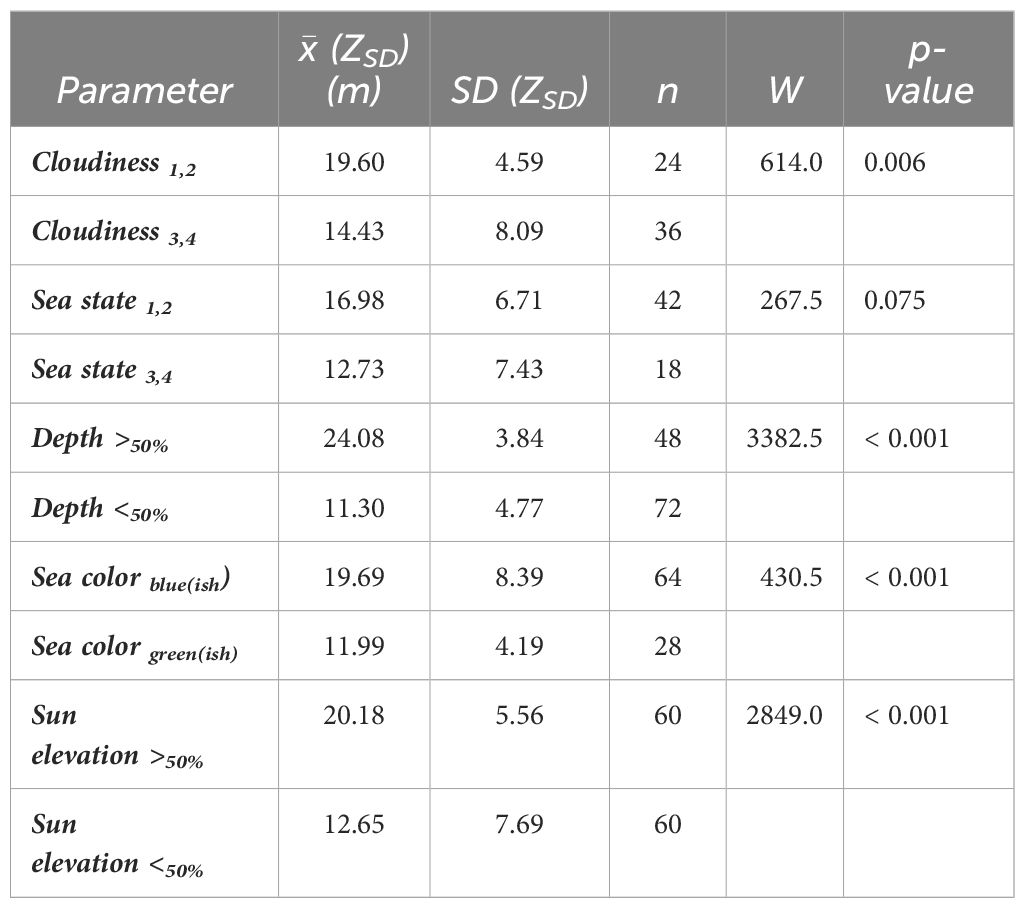
Table 8 Descriptive statistics and Mann-Whitney test results of the general effect of the environment (i.e., cloudiness, sea state, station depth, sea color, and sun elevation) on interpreting the Secchi depth (ZSD) in 2023; Means (), standard deviation (SD), number of observations (n), W-statistics, and p-values.
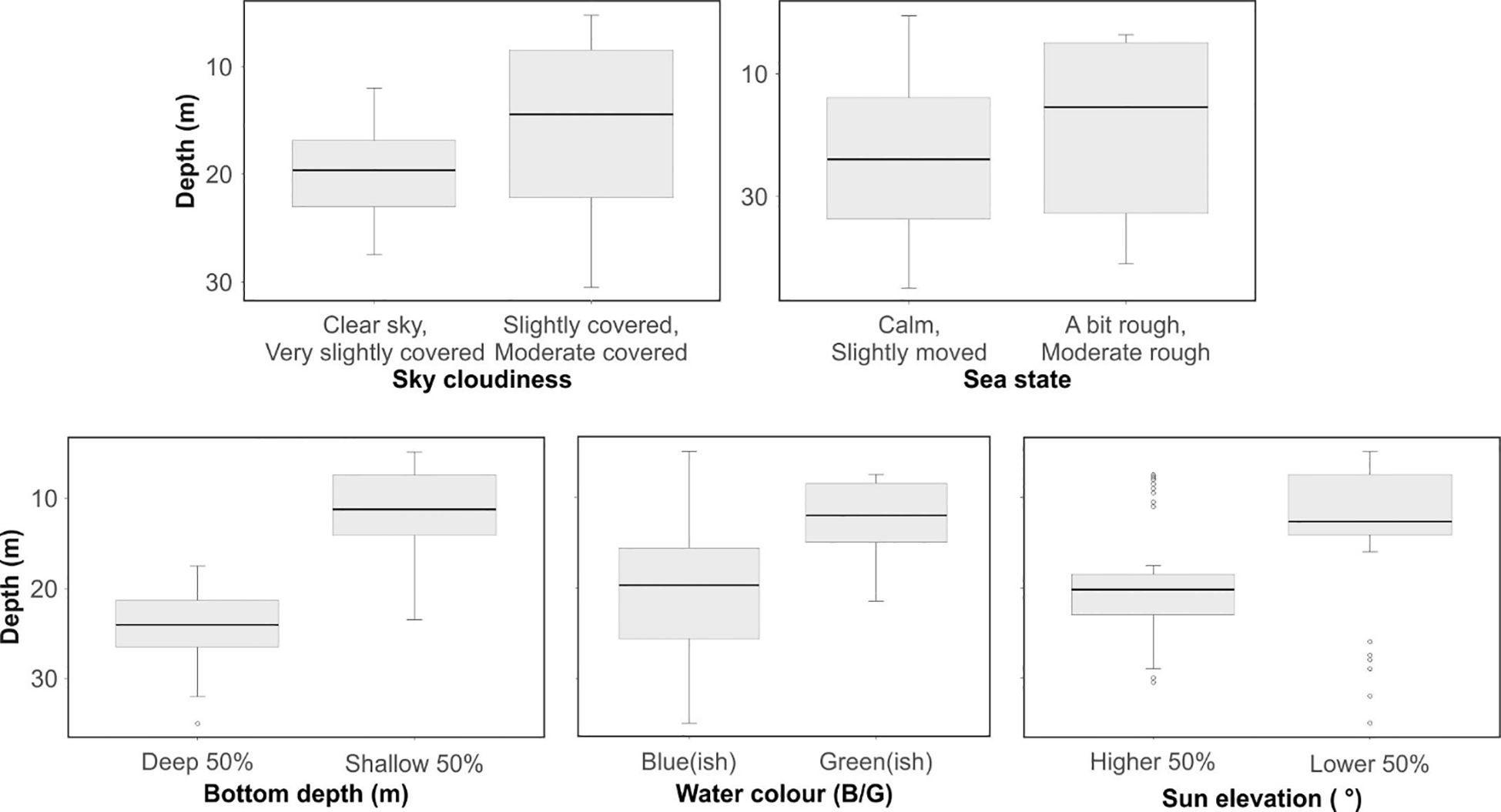
Figure 7 The general effect of weather (i.e., cloudiness, sea state), sea bottom depth, water color, and sun elevation on the Secchi depth (ZSD) observations in 2023. Otherwise, the explanations as in Figures 4, 5 and in Table 1. See text for more details.
We also analyzed the effects of station depth, sea color, and sun positioning on the perceptiveness of the Secchi depth with the Linear mixed model and with the Mann-Whitney tests. Again, only the 2023 data were included in these analyzes to avoid the significantly better visibility found in 1865 that could cause bias in the result. The depth data in the Mann-Whitney test was divided into two categories according to the median depths of the stations (deep: x ~ > 50% and shallow: x ~ < 50%), and in the analysis of the effect of sea color on perceptiveness, only those stations were included where the color of the sea, according to the observers, was clearly either blue(ish) or green(ish), and unclear B/G stations were excluded (Table 1). The analysis of the sun’s positioning was carried out with two different measurement parameters, Azimuth (indicates the position of the sun in the sky as a slope relative to the horizon when the rotation occurs from east to west) and Sun elevation (° degrees of altitude above the horizon). In sun positioning, we applied the online calculator https://planetcalc.com/4269/ which produces Azimuth and the elevation of the sun above the horizon for a given position and time. In the Mann-Whitney test of sun elevation, the height of the horizon was divided into two categories, i.e., observations below (x ~ < 50%) and above (x ~ > 50%) the median horizon altitude.
The Mann-Whitney tests showed that station depth, sea color, and sun positioning could have a biased effect on an observer’s’ perceptions (Table 8; Figure 7). Generally, at deeper and blue(ish) water stations, the Secchi depth was in a deeper water column than at the shallower green(ish) stations. This is understandable, as in deep stations, located invariably in the outer sea, the transparency of the water is typically higher than near the coast. There, the sea color is generally blue(ish), and in clearer seawater, the sunlight can penetrate deeper in the water column. Therefore, as these parameters are dependent and closely connected to each other, they tell pretty much the same story about the location of the Secchi depth. This was also the reason why bottom depth was not included in the Linear mixed model analyses. However, in the mixed model, sea color and the Azimuth (i.e., sun position) had no effect on an observer’s perceptiveness among the stations. For sea color, the reason for this was that the object of interest in the model was color assessments made among stations, not the difference between the blue(ish) and green(ish) sea color in general. Moreover, the unclear B/G water color parameter was included here in the analysis which could blur the outcome. The only variable included and showing also a statistical difference in the was Sun elevation (Table 7). The negative t-value in the Intercept revealed that when the sun is shining at low altitudes of the horizon (° < 50%), it weakens an observer’s detection ability (Table 7). The Azimuth (sun position) describes more a horizontal location of the sun, and it does not properly include the altitude measure. Thus, the high p-value in the model is reasonable.
Our main task was to evaluate the effect of subjectivity or a person’s visual perception in determining the Secchi depth (ZSD) in various circumstances to re-evaluate whether the method, developed some 160 years ago, is still functional and practical alongside modern oceanography in terms of quality characteristics. The original purpose of our work was really not to compare the historical white disk to new systems for assessing transparency of water by new devices such as photocells, hyperspectral cameras, submerged pyranometer, quantometer or similar equipment for assessing the light extinction in a water column. It is quite clear that in such a comparison, human eye made measurements would never stand up. Therefore, our answer to question posed, based on our versatile testing, is that the Secchi disk, despite its simplicity, can still be considered as a valid scientific method in environmental marine science. Therefore, it remains in place among modern electronical research and monitoring infrastructure.
Secchi disks are still being widely and regularly used to measure water transparency in both limnology and oceanography studies. Due to its low cost and easiness to operate, there have been millions of ZSD measurements, along with different sizes of disks, worldwide during the past centuries (e.g., Boyce et al., 2012). This poses a question about how reliable or comparable measurements, made by many people, can be in terms of subjectivity. Presently, marine research and environmental monitoring are widely automated with various oceanographical, biological, or other electronical observation infrastructure, where the observer’s subjectivity is significantly less. Therefore, there should always be motivation to validate older practices in how they match to scientific purposes today.
Although there always exists a small-scale individual variation in an observer’s perceptions, in the present study, we did not find that subjectivity had a significant effect on the measuring outcome. Therefore, it can be plausible that the measurement made by different people describe reliably the same narrative about the phenomenon under investigation. Moreover, one must keep in mind that measuring Secchi depth is rarely, if ever, the kind of “rocket science” that would require extreme measurement accuracy. For example, determining the thickness of the productive layer, i.e., the depth to which the intensity of the sun’s light is still sufficient to stimulate the primary production of microalgae, is basically only a rough estimate of the volume or intensity of the biological process that often gives background information for the research question under closer examination.
Overall, there are surprisingly few studies on how subjectivity affects visual depth measurement results, and Secchi himself did not assess the effect of subjectivity in his research outcomes. Rather, there exists various recommendations at an individual level regarding the use of the Secchi disk (e.g., Lind, 1985; Preisendorfer, 1986; Smith, 2001; HELCOM, 2017), but subjectivity comparisons among observers do not exist. Perhaps Preisendorfer (1986) can be seen as a pioneer who got the closest to this as he presented a, “Ten laws of the Secchi disk” for the method based on mathematical calculations for the transfer of radiance and luminance, radiance differences, photometric conversions, and air-water surface effects of light. Basically, he revealed the mathematical grounds for the verbal recommendations for the visual Secchi disk observations, and therefore this may be the first science-based study about the method. Preisendorfer (1986) eventually did not analyze the effect of subjectivity, but he stated that, “disk readings are dependent on the visual acuity of the observer and his total physiological state at the moment of measurement.” Although presented on a general level, in this way, he considered an individual’s influence in the observation.
Besides the Secchi disk usage recommendations, there have been also other suggestions for decreasing personal bias and to improve the visual detection in Secchi disk observations. Smith (2001) suggested the use of a closed ended “Viewer box,” which is an apparatus sealed around the observer’s face to increase Secchi depth measurement quality by removing the interfering effects of water surface glare and glitter. He also saw that the Viewer box also increases between-observer precision. For the highest quality work, he also gave a five-step recommendation list for the box usage of which one was dealing with the subjectivity in the case if there is more than one observer. He suggested that they should collaborate to improve the precision and eliminate gross errors in observations (Smith, 2001). A similar type of device was earlier applied by Verschuur (1997), who named it as a “Viewing tube.” Lee et al. (2015) took the ZSD method into a new era when he explained water transparency as a new idea instead of the prevailing decades old Underwater visibility theory (e.g., Duntley, 1952; Zaneveld and Pegau, 2003). He claimed that the theory may not exactly represent the sighting of a Secchi disk by a human eye. They revisited the derivations associated with the classical visibility theory and discussed the inconsistency between the theoretical predictions and observations. Based on this, they further proposed a new theory and a mechanistic model to interpret and estimate the ZSD from a wide range of aquatic environments. They proposed that the model significantly improved the current capacity in monitoring water transparency of the global aquatic environments via satellite-based remote sensing (Lee et al., 2015).
Polaroid sunglasses are commonly used in all activities occurring at sea concerning marine observation as well. This is understandable, as in intensive sunlight, the medical recommendations are that eyes should be protected especially against UV radiation. However, in almost every methodological instruction, wearing sunglasses are not recommended when using the Secchi disk (e.g., Lind, 1985; Preisendorfer, 1986; HELCOM, 2017). If using polaroid glasses when measuring, one should at least be aware that wearing sunglasses can cause a contradictory effect in Secchi disk perception. In the present study, the use of polarized sunglasses proved to be a statistically significant variable in the Linear mixed model that had a distorting influence on the measuring outcome between stations and among observers. In the near-surface depths, polarized sunglasses improved the detection of the Secchi disk, because they reduced the glare and glitter of sunlight from the surface of the water. However, when reaching greater depths, this effect changed to the opposite. Our experience showed that at deep depths, one sees worse with polarized glasses because of the darkening effect of the glasses, together with the reduction of the relative size of Secchi disk, negates the possible benefit of eliminating the sun’s sea surface reflections. We found this to be a problem especially in blue water sea areas where the transparency of the water was excellent. Thus, we agree to follow various guidelines that suggest not to use polaroid sunglasses when measuring the ZSD.
None of our models showed differences in personal, between observers, or among station ZSD determination ability regardless of a shady or sunny side of the boat. Likely, there could be at least one potential reason for the result. The boat we used in the measurements, the Pequeño Nieto, is rather small (length = 6.71 m, height = 2.59 m, draught = 0.86 m). Thus, there was a possibility that the sunlight hit again the Secchi disk when sunken deep enough under the boat. Withdrawing the boat shadow could improve the disk detection simultaneously with lessened sun’s sea surface reflections on the deck could distort the result. In any case, for the observer, such an increase of the deep-water light conditions was impossible to perceive in the middle of a measurement, but its possible influence on the outcome cannot be contested. However, the recommendation to use the shady side of the boat was originally designed to reduce sun reflections on the water surface, and that is where these instructions make its case. Therefore, we can see that the instructions on measuring from the shadow side of the boat is justified.
In general, we were able to show that environmental conditions can have an influence on ZSD determination. From the analyzed weather effects, cloudiness proved to be an important factor that impairs perception, at least when the cloud coverage in the sky is considerable, i.e., moderately covered or covered completely. However, between stations or among observers, we did not find cloudiness to present a notable difference in the ZSD measurement results in this study, which is likely due to the closely similar types of cloudy conditions during the fieldwork. In regards to sea state, we did not find cloudiness to have any significant effect on ZSD detection. However, during our survey, we did not experience the worst of sea-state conditions, the rough sea. There is no doubt that, in those circumstances, for work quality, carrying out this research is not worthy. In any case, the research showed that there is some basis to conduct meaningful research in various types of sea-state conditions.
The most obvious effect on ZSD measuring results proved to be sun elevation. Sun altitude clearly distorts the observation result if incoming sunlight comes below the horizon median. This effect was generally evident between stations or among observers as well. Our result is in accordance with the convincing work of Verschuur (1997). Based on hundreds of ZSD measurements at approximately 20-minute intervals from sunrise to sunset 12 days throughout a year, he constructed a mathematical model that showed that Secchi depth is closely dependent on solar altitude. A key point in the model is that the magnitude of the observed Secchi depth is determined by the trajectory of a beam of sunlight through the water reflecting different slopes from the disk. However, Verschuur (1997) was not the first to examine the effect of sun elevation. This pioneering study was conducted by Luksch already in 1901. He compiled a remarkable number of optical studies, which were based on analyzing hundreds of Secchi disk and water color observations collected from several expeditions during 1890 to 1898 in the Aegean, Levantine, and Red Seas. He showed the dependence of disk visibility on the sun’s elevation and proved that sun elevation and sea color are closely connected. He stated that, “The visibility depth in deep blue water increases with the increasing sun elevation. This increase is lower for the higher color numbers [greener waters]” revealing a steady dependence of Secchi disk depth on sun elevation in blue waters, while such a pattern does not appear for green waters (Luksch, 1901). His interpretations are valid also in the present study explaining most of our findings about sun elevation and sea color effects in the ZSD determination.
Our results revealed that Secchi depth was located about twofold deeper in 1865 than presently. Although there exists seasonal and annual variation in the ZSD occurrence, it cannot hardly exceed almost 100% magnitude, something more far-reaching has occurred in seawater transparency. We also found that most stations having the best visibility were presently located at blue(ish) sea areas. However, when compared to the 1865 situation, the greatest decrease in Secchi depths occurred in stations which presently are green(ish) or blue(ish). This suggests that, in 1865, the sea color in the stations was likely tinged more with blue indicating that green(ish) sea areas have today extended to a larger sea area than they were some 160 years ago. We have good reasons to argue that this likely is the case.
Transparency of the seawater is strongly associated with the quality of water and the transmittance of sunlight. Thus, depending on the location, many factors can simultaneously decrease transparency in areas that have different natural optical properties by their nature. Where nutrients and sunlight are abundant, phytoplankton (i.e., microscopic algae) increases the turbidity of the water due to eutrophication and can be a reason for the green(ish) sea color (e.g., Siokou-Frangou et al., 2010). Moreover, in river-mouth areas, runoffs could carry a heavy load of suspended matter, silt, sediments, and pollutants into the sea that increases the suspended particles in seawater. This effect can affect the physical, chemical, and biological quality of coastal waters (e.g., Montuori and Triassi, 2012). In the Tyrrhenian Sea, the environmental state of the sea follows the main trends observed in the Mediterranean Sea (e.g., Macias et al., 2006; Sole et al., 2016). During the past decades, the western coast of Italy has suffered from increasing human activities leading to anthropogenic environmental changes like eutrophication (Bosc et al., 2004). Besides, the coast is highly urbanized with heavy maritime traffic and wastewater discharges (see review of Cianelli et al., 2012), which, in term of loading, brings their own addition.
Our results agree with a similar kind of study conducted on the eastern side of the Apennine Peninsula by Justić (1988). He analyzed Secchi disk data collected from various sources in the northern Adriatic Sea during August and September, between 1911 and 1982, and showed that the Secchi disk depth has decreased substantially over time being greater near the coastline. Depending on the location, the average ZSD decrease was 4 to 6 m during the past seventy years. He considered that a decrease in light penetration has likely reduced the benthic primary production and, consequently, the depth of the euphotic layer has decreased. Justić (1988) saw that the long-term nutrient enrichment of freshwater discharge into the northern Adriatic Sea appeared to be the main factor that has caused the above changes corresponding to our interpretation for the Secchi depth decrease.
For a long time, Secchi depth has been used as a limnological characterization tool for characterization of waterbodies’ trophic state (oligotrophic-eutrophic) as it is inversely related to phytoplankton biomass (e.g., Carlson, 1977; Edmondson, 1980; Lee et al., 1995). Generally, the more is the trophic level, the lower is ZSD. The deepest recorded Secchi depth is 80 meters measured on October 13th 1986 in extreme oligotrophic conditions in the Weddell Sea, near Antarctica (Gieskes et al., 1987).
Our results showed that the Secchi disk remains a valid scientific method in environmental marine research, and therefore defends its place reliably among modern electronic devices and monitoring infrastructure. We did not find that the subjectivity of several observers had a significant effect on the measurement result. Therefore, similar measurements made by different persons describe reliably the same narrative about this phenomenon under investigation. Moreover, we must be aware that measuring with a Secchi disk is rarely, if ever, the kind of “rocket science” that would require extreme measurement accuracy. Instead, for research, the ZSD can be seen more as a relative estimate of the natural phenomenon under study providing background information. When using polaroid sunglasses in Secchi disk usage, one should at least be aware of those could cause a distortion effect in perception. Thus, we also recommend the following guidelines to not use polaroid sunglasses in the ZSD detection.
In general, environmental conditions can have a remarkable influence on ZSD determination. For example, cloudiness can be an important factor that impairs Secchi depth detection, at least when the cloud coverage in the sky is considerable. Correspondingly, sun elevation and harsh weather at sea need to be taken account in the protocol for the same reason. Thus, following the given recommendations carefully in Secchi disk usage, for example by HELCOM together with U.S. Environmental Protection Agency, North American Lake Management Society, Oceanography Society, European Environment Agency, EU Citizen Science platform, several universities and colleges, etc., is justified.
Our results also revealed that the ZSD was located about twofold deeper in 1865 than presently and cannot be explained just by seasonal or annual variation. We also found that most stations having the best visibility were presently located in blue sea areas. However, when compared to the 1865 situation, the greatest decrease in Secchi depths occurred in stations that presently are green(ish) or blue(ish). This indicated that green(ish) sea areas have today extended to a larger sea area than they were 160 years ago due to an increased turbidity of the seawater resulting from expanding human activities leading to anthropogenic environmental changes, like accelerated eutrophication, linked to urbanization, heavy maritime traffic, and wastewater discharges. Our interpretation for these underlying reasons behind higher seawater turbidity is supported from studies conducted in the other parts of the Mediterranean Sea.
The original contributions presented in the study are included in the article/supplementary material. Further inquiries can be directed to the corresponding author.
Written informed consent was obtained from the individual(s) for the publication of any identifiable images or data included in this article.
JH: Writing – review & editing, Writing – original draft, Visualization, Project administration, Methodology, Funding acquisition, Data curation, Conceptualization. JS: Writing – review & editing, Validation, Methodology, Investigation, Formal analysis, Data curation.
The author(s) declare financial support was received for the research, authorship, and/or publication of this article. This study was funded by the Weisell Foundation, Finland, which supports scientific research, education, the improvement of environmental conditions, maritime safety and research, and the preservation of maritime cultural heritage.
The study has utilized research infrastructure facilities provided by FINMARI (Finnish Marine Research Infrastructure consortium). The study contributes to the thematic collaboration of The Sea and Maritime Studies according to the strategy of Turku University. We would like to thank professor emeritus I. Vuorinen and M.Sc. J. Vuorinen for assistance during the different phases of the project implementing. We also thank Field Master Mr. Petri Kinnunen for constructing a replica from the original Secchi disk. Robert M. Badeau, M.Sc., Ph.D., of Aura Professional English Consulting (www.auraenglish.com), performed the language services.
The authors declare that the research was conducted in the absence of any commercial or financial relationships that could be construed as a potential conflict of interest.
All claims expressed in this article are solely those of the authors and do not necessarily represent those of their affiliated organizations, or those of the publisher, the editors and the reviewers. Any product that may be evaluated in this article, or claim that may be made by its manufacturer, is not guaranteed or endorsed by the publisher.
Barker G., Rasmussen T. (2000). The Etruscans. The Peoples of Europe (Oxford: Blackwell Publishing), ISBN: ISBN 978–0-631–22038-1.
Bates D., Maechler M., Bolker B., Walker S. (2015). Fitting linear mixed-effects models using lme4. J. Stat. Software 67, 1–48. doi: 10.18637/jss.v067.i01
Bosc E., Bricaud A., Antoine D. (2004). Seasonal and interannual variability in algal biomass and primary production in the Mediterranean Sea, as derived from 4 years of SeaWiFS observations. Global Biogeochem. Cy. 18, GB1005. doi: 10.1029/2003GB002034
Bowers D. G., Roberts E. M., Hoguane A. M., Fall K. A., Massey G. M., Friedrichs C. T. (2020). Secchi disk measurements in turbid water. J. Geophys. Res. 125, e2020JC016172. doi: 10.1029/2020JC016172
Boyce D. G., Lewis M., Worm B. (2012). Integrating global chlorophyll data from 1890 to 2010. Limnol. Oceanog.-Meth. 10, 840–852. doi: 10.4319/lom.2012.10.840
Burggraaff O., Panchagnula S., Snik F. (2021). Citizen science with colour blindness: A case study on the Forel-Ule scale. PloS One 16, e0249755. doi: 10.1371/journal.pone.0249755
Carlson R. E. (1977). Trophic state index for lakes. Limnol. Oceanogr. 22, 361–369. doi: 10.4319/lo.1977.22.2.0361
Chinnici I. (2019). Decoding the Stars: A Biography of Angelo Secchi, Jesuit and Scientist. Ed. Maryks R. A. (The Netherlands: Brill, Leiden).
Cianelli D., Uttieri M., Buonocore B., Falco P., Zambardino G., Zambianchi E. (2012). “Dynamics of a very special Mediterranean coastal area: the Gulf of Naples,” in Mediterranean Ecosystems: Dynamics, Management and Conservation. Ed. Williams G. S. (Nova Science Publishers, New York, USA), 129–150.
Duntley S. Q. (1952). The visibility of submerged objects Vol. 1952) (San Diego: Visibility Lab., Mass. Inst. Tech, Scripps Institution of Oceanography), 74.
Edmondson W. T. (1980). Secchi disk and chlorophyll. Limnol. Oceanogr. 25, 378–379. doi: 10.4319/lo.1980.25.2.0378
Gieskes W. W. C., Veth C., Woehrmann A., Graefe M. (1987). Secchi disc visibility world record Shattered Vol. 68 (EOS, Transactions, American Geophysical Union), 123. doi: 10.1029/EO068i009p00123-01
HELCOM (2017). Guidelines for monitoring of water transparency (Secchi depth) (Helsinki, Finland: HELCOM). 4pp.
Iacono R., Napolitano E., Palma M., Sannino G. (2021). The tyrrhenian sea circulation: A review of recent work. Sustainability 13, 6371. doi: 10.3390/su13116371
Justić D. (1988). Trend in the transparency of the northern Adriatic Sea 1911–1982. Mar. pollut. Bull. 19, 32–35. doi: 10.1016/0025–326X(88)90751–5
Krivosheya V. G. (1983). Water circulation and structure in the Tyrrhenian Sea. Oceanology 23, 166–171.
Lee G. F., Jones-Lee A., Rast W. (1995). Secci Depth as a Water Quality Parameter. Report of G. Fred Lee & Associates (El Macero, CA, USA: G. Fred Lee and Associates).
Lee Z.-P., Shang S., Hu C., Du K., Weidemann A., Hou W., et al. (2015). Secchi disk depth: A new theory and mechanistic model for underwater visibility. Remote Sens. Environ. 169, 139–149. doi: 10.1016/j.rse.2015.08.002
Lind O. T. (1985). Handbook of Common Methods in Limnology. 2nd edition (USA: Kendall/Hunt Publishing Co.), 199, ISBN: ISBN: 0840337531.
Luksch J. (1901). Untersuchungen über die Transparenz und Farbe des Seewassers. (Mit 3 Tafeln und 11 Textfiguren.), Berichte der Commission für Erforschung des östlichen Mittelmeeres. (Erste Reihe.) Denkschriften der Akademie der Wissenschaften. Math. Natw. Kl. Frueher: Denkschr. der Kaiserlichen Akad. der Wissenschaften. Fortgesetzt: Denkschr. oest. Akad Wiss. Mathem. Naturw. Klasse. Austrian Empire (Austria-Hungary): K.K. Hof- und Staatsdruckerei.
Macias D., García C. M., Echevarría F., Vázquez-Escobar A., Bruno M. (2006). Tidal induced variability of mixing processes on Camarinal Sill (Strait of Gibraltar). A pulsating event. J. Mar. Syst. 60, 177–192. doi: 10.1016/j.jmarsys.2005.12.003
Millot C. (1999). Circulation in the western Mediterranean sea. J. Mar. Syst. 20, 423–442. doi: 10.1016/S0924-7963(98)00078-5
Millot C., Taupier-Letage I. (2005). “Circulation in the Mediterranean Sea,” in The Mediterranean Sea. Handbook of Environmental Chemistry, vol. 5K . Ed. Saliot A. (Springer, Berlin, Heidelberg). doi: 10.1007/B107143
Montuori P., Triassi M. (2012). Polycyclic aromatic hydrocarbons loads into the Mediterranean Sea: estimate of Sarno River inputs. Mar. pollut. Bull. 64, 512–220. doi: 10.1016/j.marpolbul.2012.01.003
Pierini S., Simioli A. (1998). A wind-driven circulation model of the Tyrrhenian Sea area. J. Mar. Syst. 18, 161–178. doi: 10.1016/S0924-7963(98)00010-4
Pinardi N., Navarra A. (1993). Baroclinic wind adjustment processes in the Mediterranean Sea. Deep Sea Res. Part II. 40, 1299–1326. doi: 10.1016/0967-0645(93)90071-T
Pitarch J. (2017). Biases in ocean color over a Secchi disk. Opt. Express 25, A1124–A1131. doi: 10.1364/OE.25.0A1124
Pitarch J. (2020). A review of Secchi’s contribution to marine optics and the foundation of Secchi disk science. Oceanography 33, 26. doi: 10.5670/oceanog.2020.301
Posit team (2023). RStudio: Integrated Development Environment for R (Boston, MA: Posit Software, PBC). Available at: http://www.posit.co/.
Preisendorfer R. W. (1986). Secchi disc science: visual optics of natural waters. Limnol. Oceanogr. 31, 909–926. doi: 10.4319/lo.1986.31.5.0909
Sánchez-Garrido J. C., Naranjo C., Macias D., Garcia-Lafuente J., Oguz T. (2015). Modeling the impact of tidal flows on the biological productivity of the Alboran Sea. J. Geophys. Res.-Oceans 120, 7329–7345. doi: 10.1002/2015JC010885
Secchi A. (1860). Catalogo di 1321 stelle doppie misurate col grande equatoriale di Merz all’Osservatorio del Collegio Romano, e confrontate colle misure anteriori (Roma: Tipografia delle belle arti), 120.
Secchi A. (1863). “Sull’ecclisse solare totale osservato in Spagna nel 18 luglio 1860,” in Memorie dell’Osservatorio del Collegio Romano, vol. 2. , 33–52. Roma, Italy: Osservatorio Astronomico di Roma, Instituto.
Secchi A. (1865). Relazione delle esperienze fatte a bordo della pontificia pirocorvetta Imacolata Concezione per determinare la trasparenza del mare; Memoria del P.A. Secchi Vol. 20 (Rome, Italy: Il Nuovo Cimento), 205–238.
Secchi A. (1870). Descrizione del meteorografo dell’Osservatorio del Collegio Romano (Roma: Belle Arti), 96.
Siokou-Frangou I., Christaki U., Mazzocchi M. G., Montresor M., Ribera D’alcalá M., Vaqué D., et al. (2010). Plankton in the open Mediterranean Sea: A review. Biogeosciences 7, 1543–1586. doi: 10.5194/bg-7-1543-2010
Smith D. G. (2001). A protocol for standardizing secchi disk measurements, including use of a viewer box. Lake Reservoir Manage 17, 90–96. doi: 10.1080/07438140109353977
Sole J., Ballabrera-Poy J., Macias D., Catalan I. A. (2016). The role of ocean velocity in chlorophyll variability. A modelling study in the Alboran Sea. Sci. Mar. 80S1, 249–256. doi: 10.3989/scimar.04290.04A
Verschuur G. L. (1997). Transparency measurements in garner lake, tennessee: the relationship between secchi depth and solar altitude and a suggestion for normalization of secchi depth data. Lake Reservoir Manage. 13, 142–153. doi: 10.1080/07438149709354305
Wernand M. R. (2010). On the history of the Secchi disc. J. Eur. Opti. Soc – Rapid Publ. 5, 1-6. doi: 10.2971/jeos.2010.10013s
Wernand M. R., van der Woerd H. J. (2010). Spectral analysis of the Forel-Ule Ocean colour comparator scale. J. Eur. Opti. Soc – Rapid Publ. 5, 1-7. doi: 10.2971/jeos.2010.10014s
Keywords: Angelo Secchi, Secchi disk, Secchi depth (ZSD), transparency, perception, Tyrrhenian sea
Citation: Hänninen J and Sahlstén J (2024) Re-evaluation of Padre Secchi’s visual method for modern oceanography. Front. Mar. Sci. 11:1400397. doi: 10.3389/fmars.2024.1400397
Received: 13 March 2024; Accepted: 04 June 2024;
Published: 19 June 2024.
Edited by:
Oliver Zielinski, Leibniz Institute for Baltic Sea Research (LG), GermanyReviewed by:
Frano Matić, University of Split, CroatiaCopyright © 2024 Hänninen and Sahlstén. This is an open-access article distributed under the terms of the Creative Commons Attribution License (CC BY). The use, distribution or reproduction in other forums is permitted, provided the original author(s) and the copyright owner(s) are credited and that the original publication in this journal is cited, in accordance with accepted academic practice. No use, distribution or reproduction is permitted which does not comply with these terms.
*Correspondence: Jari Hänninen, amFyaGFuQHV0dS5maQ==
Disclaimer: All claims expressed in this article are solely those of the authors and do not necessarily represent those of their affiliated organizations, or those of the publisher, the editors and the reviewers. Any product that may be evaluated in this article or claim that may be made by its manufacturer is not guaranteed or endorsed by the publisher.
Research integrity at Frontiers

Learn more about the work of our research integrity team to safeguard the quality of each article we publish.